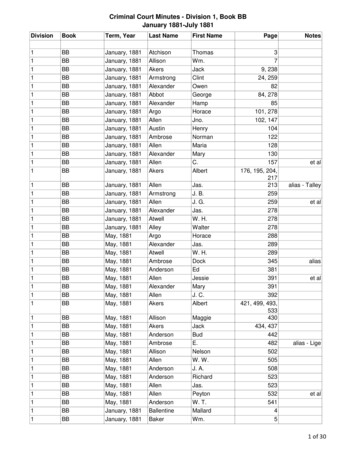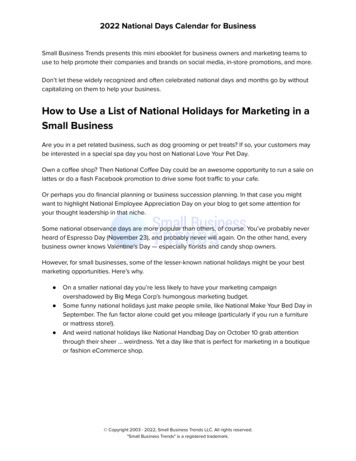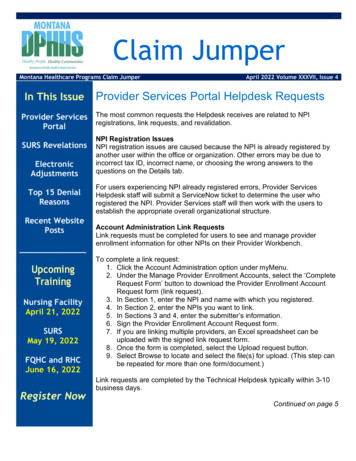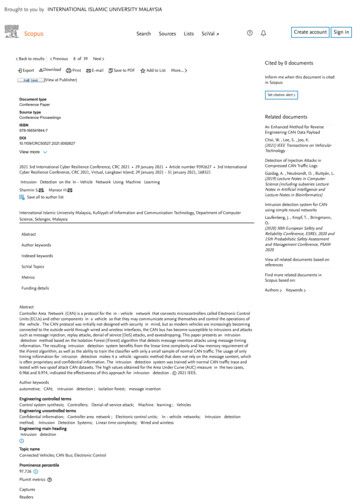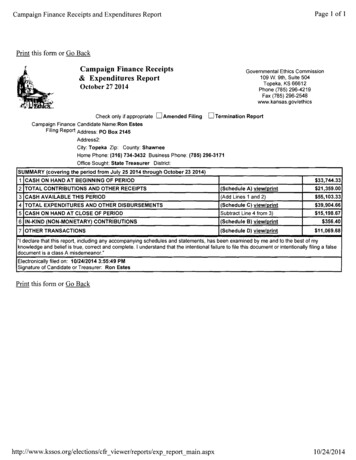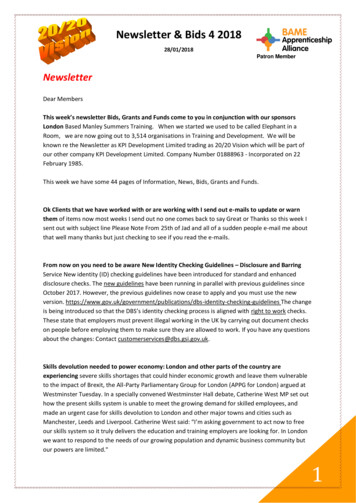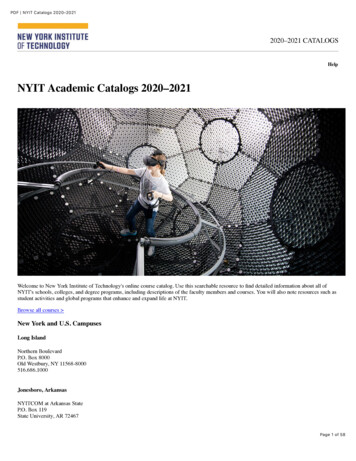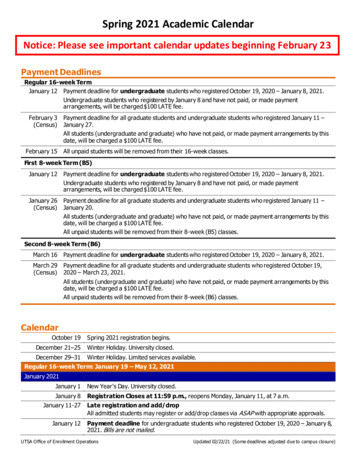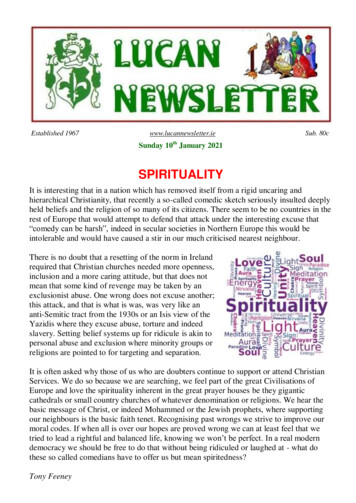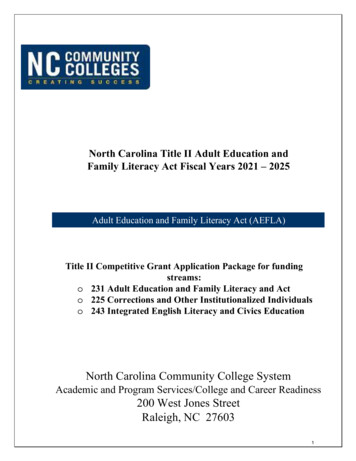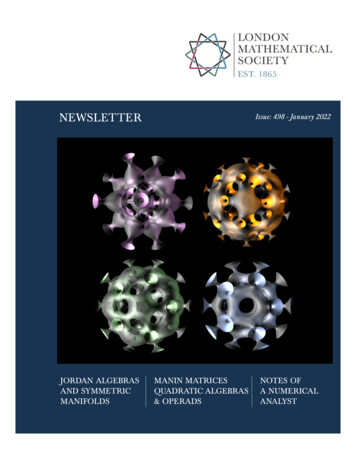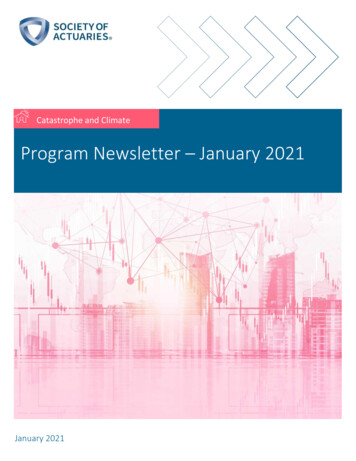
Transcription
Catastrophe and ClimateProgram Newsletter – January 2021January 2021
2Catastrophe and Climate StrategicResearch Program NewsletterJanuary 2021CONTRIBUTORSMichael Fung, FSA, CERAALM and Capital ActuaryFWDHKSPONSORSOA Catastrophe & Climate StrategicResearch Program Steering CommitteeSam Gutterman, FSA, FCAS, MAAA, CERA,FCA,HonFIA retired, consulting actuaryPriya Rohatgi, ASAMember of SOA Catastrophe & ClimateStrategic Research Program SteeringCommitteeMax J. Rudolph, FSA, CERA, CFA, MAAAPrincipalRudolph Financial Consulting LLCCaveat and DisclaimerThe opinions expressed and conclusions reached by the authors are their own and do not represent any official position or opinion of the Society ofActuaries or its members. The Society of Actuaries makes no representation or warranty to the accuracy of the information.Copyright 2021 by the Society of Actuaries. All rights reserved.Copyright 2021 Society of Actuaries
3CONTENTSFocus on Terminology: Anomaly - Are we talking past each other? . 4IPCC Definitions . 4Dictionary Definitions . 4From the Climate Scientists . 4From the Actuary . 4Summary . 4Featured Research Project – Environmental Risk Paper Series . 5Introduction to Environmental Risks . 5Environmental Risk from Globalization . 5Climate Change and Environmental Risk . 5Sustainable Insurance: A Changing International and National Landscape. 5In the News . 6Studies/Research Published Outside the SOA . 9Institute and Faculty of Actuaries (IFoA) and Canadian Institute of Actuaries Statements . 9Relationship Between Residential Losses and Hurricane Winds: Role of the Florida Building Code . 10Book Review of Angry Weather by Dr. Friederike Otto . 10About The Society of Actuaries . 13Copyright 2021 Society of Actuaries
4Focus on Terminology: Anomaly - Are we talking past each other?By Max J. Rudolph, Dr. Jesse Bell, and Steve BowenFor those actuaries who desire to become more active in climate awareness activities, there are times whenlanguage becomes an issue. Terms that have been used for decades in each specialty are used in ways that meansomething else to the other groups. This column will likely be a semi-recurring feature of this newsletter, so pleaselet us know (max.rudolph@rudolph-financial.com ) if you have a term that you think actuaries, climatologists orpeople working in sustainability use in different ways. The format will be to introduce and define commonly usedterminology that is used by multiple fields. The hope is that having an awareness of vocabulary differences betweenthese different fields will improve communications between them.A climate anomaly compares present state with future state scenarios; while most standard anomalies comparepresent state to past state.IPCC DEFINITIONS1Anomaly – The deviation of a variable from its value averaged over a reference period.DICTIONARY DEFINITIONSAnomaly – Something that deviates from what is standard, normal, or expected.FROM THE CLIMATE SCIENTISTSFor the climate scientist, or someone working on environmental sustainability, an anomaly compares historical datawith a future state in a specific scenario. This works well with the RCP scenarios, where a future global temperaturecould be compared to a historical data set.FROM THE ACTUARYA typical use of the word anomaly would be to compare the present state of against the typical historical state. Anactuary who works with models likely is aligned with the climate scientist but may use the term in multiple ways. Wemight think of future hyperinflation in a scenario as an anomaly, but also view the currently low level of interestrates as an anomaly.SUMMARYActuaries have much to learn from climate scientists and those working in sustainability, but it’s important that wenot talk past each other. In this case, anomaly as used by the layman would compare only the present againstIPCC, 2018: Summary for Policymakers. In: Global Warming of 1.5 C. An IPCC Special Report on the impacts of global warming of 1.5 C abovepre-industrial levels and related global greenhouse gas emission pathways, in the context of strengthening the global response to the threat ofclimate change, sustainable development, and efforts to eradicate poverty [Masson-Delmotte, V., P. Zhai, H.-O. Pörtner, D. Roberts, J. Skea, P.R.Shukla, A. Pirani, W. Moufouma-Okia, C. Péan, R. Pidcock, S. Connors, J.B.R. Matthews, Y. Chen, X. Zhou, M.I. Gomis, E. Lonnoy, T. Maycock, M.Tignor, and T. Waterfield (eds.)]. World Meteorological Organization, Geneva, Switzerland, 32 pp. ht 2021 Society of Actuaries
5historical data, while those who build scenarios of the future (both climate scientists and actuaries) will alsocompare the future state.Max Rudolph is a principal at Rudolph Financial Consulting, LLC.Dr. Jesse Bell is the Claire E. Hubbard Professor of Health and Environment at the University of Nebraska MedicalCenter.Steve Bowen is a Meteorologist and the Head of Catastrophe Insight at Aon.Featured Research Project – Environmental Risk Paper SeriesBy Priya RohatgiStarting November 2020, the Climate & Environmental Sustainability Research Committee (CESRC), a subCommittee of the Catastrophe & Climate Strategic Research Program Steering Committee, started publishingresearch papers that are a part of an introductory series called The Environmental Risk Paper series. These arerelatively short papers that intend to provide an accessible overview of the latest research and developments on theselected topics. Though the series is curated with a focus on actuarial practice it will be of interest to allstakeholders.The key objective of the series is to promote a holistic awareness of different risks and their inter-connectednesswhich are often amplified by climate change. Over time this will serve as a good resource for actuaries to guide andsupport their work in a rapidly changing world. Below are the papers that have been published through January2021.INTRODUCTION TO ENVIRONMENTAL RISKSThis report will endeavor to introduce the reader to some of the known and developing environmental risks thatimpact the business of insurance, with a specific focus on North American risks. ronmental-risk.pdfENVIRONMENTAL RISK FROM GLOBALIZATIONThis paper looks at Globalization, which causes insurable loss through disease, crop damage, infrastructure damage,and ecosystem services damage. isk-globalization.pdfCLIMATE CHANGE AND ENVIRONMENTAL RISKClimate change is occurring. As a result, insured and uninsured losses are increasing. Billion-dollar (CPI adjusted)disaster events have increased in each decade in which they have been tracked since ate-change-environmental-risks.pdfSUSTAINABLE INSURANCE: A CHANGING INTERNATIONAL AND NATIONAL LANDSCAPEHere, are summarized some of the developments in corporate sustainability. The guiding principles of corporatesustainability are developed on the global stage, but implementation of these principles necessarily occurs at theindividual company level. international-landscape.pdfCopyright 2021 Society of Actuaries
6In the NewsBy Michael FungHere are some recent articles focusing on catastrophe, climate, and insurance. As you click through the articlesbelow, we invite you to consider how these phenomena and trends can impact actuarial applications, and to noteany associations to economic and insured losses.1)2020 set to be one of the three warmest years on Its provisional assessment suggests this year will be one of the three hottest, just behind 2016 and 2019.The warmest six years in global records dating back to 1850 have now all occurred since 2015. The mostnotable warmth was in the Siberian Arctic, where temperatures were 5 degrees Celsius above average.Climate change: 2020 set to be one of the three warmest years on recordProvisional figures indicate that 2020 will be one of the hottest in a record dating backto 1850.www.bbc.com2)“For the first time, potentially ever, finance policy is being used as climate policy, which is a fundamentalshift—it never has been in the past” Justin Guay, director of global climate strategy at the Sunrise -stress-testThe economist and the climate financial proponents urge the bank regulators to expand the stress testingscope to cover climate risks.How a Climate 'Stress Test' Can Foresee Collapsing Banks - Scientific Americanwww.scientificamerican.com3)What's happening in the ures-above-normalEven though the temperature feels normal where people live, the truth is that the "cold" generator in theNorth Pole no longer works as normal due to factors like sea ice thinning. The climate over the North Poleis just getting warmer than you could have ever imagined.Copyright 2021 Society of Actuaries
74)What's the true tone of the Arctic? White? OR is it graphers have captured images from the Arctic regions which shown beautiful greenish landscapes,where they were supposed to be in white instead.Beautiful Yet Unnerving Photos of the Arctic Getting Greener WIREDThe Arctic is getting greener, and it’s about as pretty as you might expect—vaststretches of coastal land positively glowing against cobalt seas. But all that green is infact an alarm .www.wired.com5)Increasing Cat bond adsThe view in the future P&C outlook and uncertainties can be observed through the spread movement ofthe Catastrophe Bond markets. An increasing trend is what we can see over the past few years.Catastrophe bond spreads back at their highest since 2012/13 - Artemis.bmArtemis’ data on the catastrophe bond market shows that excess spreads, so the returnavailable above expected loss, of new issuance so far in 2020 is now back at levels lastseen in 2012/13 .www.artemis.bmCopyright 2021 Society of Actuaries
86)Not everything can be -without-homeowners-insuranceAfter the wildfire happened in recent years, the non-renewal rates of property insurance have jumped to 30% to 60% in different regions of California. For the lucky ones who will be able to renew their insurance,the prices won't be what they expect.Wildfire Risk Leaves Californians Without Homeowners InsuranceThe problem has been getting worse. In October, California’s insurance regulator reported thatinsurers refused to renew 235,250 home insurance policies in 2019, a 31% increase from theprior year. In ZIP codes that had a moderate to very high fire risk, non-renewals jumped 61%.www.bloombergquint.com7)Outlook to 2021 Life and non-Life Insurance ensify-credit-pressures-for-french-insuranceThis report from Fitch on the insurance market outlook in 2021 can be used as a reference for these 2major types of insurance businesses in other regions, on the key elements, especially the pandemic, thatimpact the credit ratings / profitability of insurers.Pandemic to Intensify Credit Pressures for French InsuranceFitch Ratings 2021 Outlook: French Insurance Fitch Ratings-London/Paris-23 November 2020: FitchRatings' sector outlook for the French insurance sector in 2021 is worsening for the life segment and isstable for non-life. The sector outlook is based on an updated www.fitchratings.comCopyright 2021 Society of Actuaries
98)Insurers hoping for more Government limate-change-suiteBased on recent experience in catastrophes, the Insurers are hoping for more support from the proclimate change government administration.Allstate Corp CEO eyes climate insurance plan under potential Biden win ReutersAllstate Corp ALL.N wants a potential Democratic administration to back a taxpayerfunded program that would pay for losses caused by the largest climate-change fuelednatural disasters, the .www.reuters.com9)Consultants are gearing atsonOne of the major insurance consulting firms has recently bought climate change analytical business to helpexpand their business into the climate area, which indicates the increasing awareness of climate risk in theinsurance industry.Willis Towers Watson buys climate change advisory business Insurance TimesThe purchase will align with WTW’s focus on physical climate risks and resilience via its Climateand Resilience Hub Global advisory and broking business Willis Towers Watson (WTW) hasbought climate change adaptation advisory and analytics business Acclimatize in order tobroaden its service .www.insurancetimes.co.ukStudies/Research Published Outside the SOAINSTITUTE AND FACULTY OF ACTUARIES (IFOA) AND CANADIAN INSTITUTE OF ACTUARIES STATEMENTSBy Sam GuttermanThe IFoA has been active in promoting the role of actuaries and supporting its members on environmental issues. Ithas developed several research projects, provided continuing professional development opportunities and briefingnotes, and published several practical guides to its members describing the effects of these issues in actuarialpractice. It has a Sustainability Board (one of six boards) that is responsible for the IFoA’s Resource and Environmentpractice area.IFoA recently published a statement ment) with an objective ofstating the urgency of mitigating risks associated with the change in global climate. Overarching themes includedCopyright 2021 Society of Actuaries
10support for a net-zero sustainable economy achieved in a socially just manner. It indicates seven steps the IFoA willtake, including: (1) advocating for the development of consistent policy frameworks worldwide to achieve the ParisAgreement objectives in a just manner, (2) advocating the development of effective methods of incentivizingreductions in greenhouse gas emissions, (3) using the actuarial skill set and influence to help global financial marketsachieve a sustainable transition to net zero, (4) supporting actuaries to better understand climate risks andopportunities and encouraging their incorporation into actuarial advice, (5) advocating that corporations and marketparticipants effectively disclose their environmental risks, (6) supporting collaborations both amongst its membersand with other organizations to help align national and global financial systems with a net-zero sustainableeconomy, and (7) implementing a plan to be operationally net zero by 2030.Similarly, the Canadian Institute of Actuaries released a public statement in September 2019 tails/219104) entitled “Time to Act: Facing the Risks of a Changing Climate”. Thisstatement boldly indicated that action is needed to: prioritize relevant data collection pertinent to the financialimpacts of climate-related events, implement policies that accelerate climate-risk financial reporting requirements,and account for climate-related factors in investment and corporate risk planning.I encourage you to become familiar with these statements.RELATIONSHIP BETWEEN RESIDENTIAL LOSSES AND HURRICANE WINDS: ROLE OF THE FLORIDA BUILDINGCODEBy Priya RohatgiThe paper: Relationship Between Residential Losses and Hurricane Winds: Role of the Florida Building Code byauthors James M. Done, Ph.D.; Kevin M. Simmons, Ph.D.; and Jeffrey Czajkowski, Ph.D. is recommended byCatastrophe & Climate Steering Committee member Cindy Bruyere, National Center for Atmospheric Research as agreat read for those who are interested in understanding and quantifying the effectiveness of building codes againstdifferent wind field parameters and thereby reducing hurricane losses. This might be helpful for those involved withdeveloping future building codes and future hurricane adaptation strategies.Recent studies have shown that wind speed is not the only wind field parameter that can derive wind-related losses.Wind duration and steadiness – a measure of wind directional change, are also important. Focusing on sevenhistorical hurricanes that impacted Florida during 2004 and 2005 and the Florida building code which wasimplemented statewide in the early 2000s, the paper builds on the existing literature in two important ways – first,it quantifies the relative importance of the different wind field parameters in driving hurricane wind losses andsecond, it quantifies the effectiveness of the Florida building code in lowering losses associated with the differentwind field parameters. The paper is available at 0947Book Review of Angry Weather by Dr. Friederike OttoBy Max J. RudolphDr. Otto wrote this book in 2019 and it was translated to English in 2020. It surprised me by its lack of numericalexamples and technical details about attribution but provided enough info to get across the basic concepts. Foractuaries and statisticians, it is easy to follow. The basic concept is that, pre climate change, a given event (e.g.,hurricane, tornado) had a specific probability distribution and financial impact (think of a normal distribution)consistent with pre-industrial revolution temperatures. By updating the probability distribution based on recentdata, the distributions can be compared. The difference between expected likelihood pre- and post-temperatureCopyright 2021 Society of Actuaries
11increase generates an event attribution. One might say there is a XX% greater chance of a billion-dollar hurricanehitting Miami today than in the past.One point that seems to be made in every book I read lately is that socioeconomic status matters. Those who areimpacted most are those who have the least – developing countries, outdoor workers, those who can’t affordinsurance – compared to those who have benefited most from societies based on fossil fuels. This is true inBangladesh and Africa, but also the slums of Chicago, Baltimore, and Miami.Dr. Otto belongs to a World Weather Attribution team, one of the leading groups behind event attribution science.Her group tries to provide facts where there is uncertainty, commenting on the likelihood of events often called actsof God. Overstating the impact of climate change will lead to push back. Understating the impact leads to inactionand a worse future. The book follows the team’s efforts during Hurricane Harvey in 2017, when Houston wasinundated by rain for several days in an area where infrastructure is not equipped to process the water.Unwillingness of the people living there to evacuate did not help, nor did a lack of infrastructure or zoning laws –homeowner beware.As the Actuaries Climate Index has shown releases/2019/climate-index-climbs/ ), as the climate warms extreme conditions are increasing. More heat waves,more water in the atmosphere, more favorable conditions for hurricanes to form. The jet stream appears to bechanging as the Arctic ice melts, and clouds are changing in uncertain ways, leaving storms hovering over one spotlonger than they used to. Air and water circulation patterns are changing, sometimes with positive reinforcement,but not always. Global, regional, and local factors are all in play. Climate deniers use this information to confuse thepublic, identifying areas which counter the overall trend.The qualitative argument for Hurricane Harvey being a bigger event than it would have been in the past includedwarmer oceans and higher relative humidity. A Category 4 hurricane, it dropped over 39 inches of rain over 3 daysand inflicted 125 billion in damages. Using extreme value statistics, similar events are estimated to occur once in9,000 years. Does this make it an event worthy of developing adaptation techniques? How likely an event is it goingforward? How do I define event – do I combine events occurring anywhere along the Texas coast? Over time thesequestions will be answered, and a consistent framework developed. Dr. Otto, and others like her, are helping toprovide information that will allow better decisions to be made.This book was interesting but could have been better if they shared a few charts along the way. One that would helpconfirm my understanding would include a probability distribution curve consistent with fossil fuel use prior to theIndustrial Revolution. A 30-year historical distribution could overlay it with the rest of the curve estimated. Thiswould graphically demonstrate the concepts being developed.Attribution science is best performed when serving two masters. Peer reviewed papers remain important to thescientist and are harder to sneak through poor research but providing information that can impact policy decisionsmust be provided while the news cycle is fresh. Academics are uncomfortable with papers that are released quickly,without multiple passes for comments. This community is learning how to adapt and generate useful informationduring the COVID-19 crisis, and this will carry over to climate and other fields.The base data assumes an environment as if the Industrial Revolution had not occurred. This is then compared withthe world we live in today for event attribution. It could also be used to anticipate and plan to mitigate or adapt tofuture events. Feedback loops in the data will likely underestimate the likelihood of these extreme events in thefuture as permafrost and ice melts, or carbon in the atmosphere reaches a tipping point that changes basicassumptions like cloud formation. Hopefully there will be some positive events as well, perhaps due togeoengineering techniques that filter out carbon from the atmosphere and oceans.Copyright 2021 Society of Actuaries
12To be statistically significant, the most recent 30-year period is used to compare to this historical fiction. Then thecurrent event is noted and the difference in likelihood between the two distributions is noted. Their calculationsshowed Harvey to be three times as likely as it would have been, and every degree of temperature increase (Celsius)leads to this type of torrential rain as being three times as likely. Since all areas of the earth do not react in auniform way to climate change, there could be a decrease in likelihood of some events in some locations.The value of attribution analysis is that it allows planners to be proactive. In the United States our natural tendencyis to ignore growing threats and react once the disaster has occurred, promising often to rebuild as it was before.Event attribution makes quantitative analysis available to those who are interested in using it, allowing mitigationand adaptation to occur before a similar (or worse) event occurs. I saw an example of this in Rapid City, SouthDakota a few years ago. They sustained a horrible flood in 1972. Their reaction was not to rebuild as it was, but torebuild homes and businesses in safer areas and create a flood plain that is a beautiful park. I think they would arguethat common sense was involved, and I would agree. It’s a much better solution than buying sandbags every fewyears and asking the government to repeatedly bail you out. Over a century ago a hurricane devastated Galveston.Instead of rebuilding, in a form of climate migration, businesses moved up the coast to what is now Houston and thepopulation followed.Climate change is not the only thing changing. Construction, roads, and other human factors also come into play.Financial impact, along with social upheaval and deaths, should all be considered. This type of analysis needs tobecome mainstream. Scientists should include financial experts in the analysis, including actuaries.Copyright 2021 Society of Actuaries
13About The Society of ActuariesWith roots dating back to 1889, the Society of Actuaries (SOA) is the world’s largest actuarial professionalorganizations with more than 31,000 members. Through research and education, the SOA’s mission is to advanceactuarial knowledge and to enhance the ability of actuaries to provide expert advice and relevant solutions forfinancial, business and societal challenges. The SOA’s vision is for actuaries to be the leading professionals in themeasurement and management of risk.The SOA supports actuaries and advances knowledge through research and education. As part of its work, the SOAseeks to inform public policy development and public understanding through research. The SOA aspires to be atrusted source of objective, data-driven research and analysis with an actuarial perspective for its members,industry, policymakers and the public. This distinct perspective comes from the SOA as an association of actuaries,who have a rigorous formal education and direct experience as practitioners as they perform applied research. TheSOA also welcomes the opportunity to partner with other organizations in our work where appropriate.The SOA has a history of working with public policymakers and regulators in developing historical experience studiesand projection techniques as well as individual reports on health care, retirement and other topics. The SOA’sresearch is intended to aid the work of policymakers and regulators and follow certain core principles:Objectivity: The SOA’s research informs and provides analysis that can be relied upon by other individuals ororganizations involved in public policy discussions. The SOA does not take advocacy positions or lobby specific policyproposals.Quality: The SOA aspires to the highest ethical and quality standards in all of its research and analysis. Our researchprocess is overseen by experienced actuaries and nonactuaries from a range of industry sectors and organizations. Arigorous peer-review process ensures the quality and integrity of our work.Relevance: The SOA provides timely research on public policy issues. Our research advances actuarial knowledgewhile providing critical insights on key policy issues, and thereby provides value to stakeholders and decisionmakers.Quantification: The SOA leverages the diverse skill sets of actuaries to provide research and findings that are drivenby the best available data and methods. Actuaries use detailed modeling to analyze financial risk and providedistinct insight and quantification. Further, actuarial standards require transparency and the disclosure of theassumptions and analytic approach underlying the work.Society of Actuaries475 N. Martingale Road, Suite 600Schaumburg, Illinois 60173www.SOA.orgCopyright 2021 Society of Actuaries
The warmest six years in global records dating back to 1850 have now all occurred since 2015. The most notable warmth was in the Siberian Arctic, where temperatures were 5 degrees Celsius above average. . WIRED The Arctic is getting greener, and it's about as pretty as you might expect—vast
